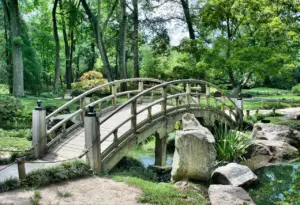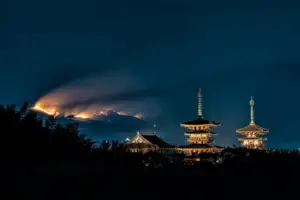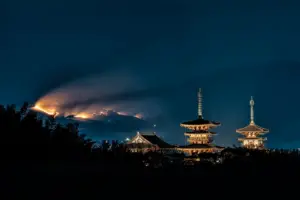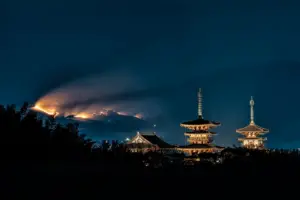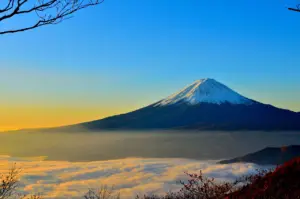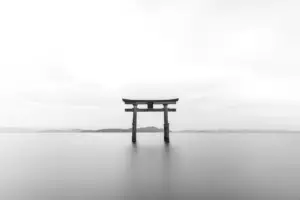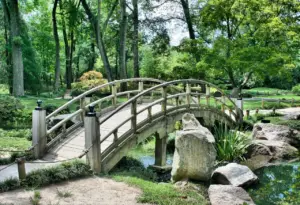Are you itching for a new adventure, craving to explore a lesser-known side of Japan? Look no further than Nara’s hidden gems.
This ancient city, nestled in the heart of Japan’s Kansai region, is home to a plethora of off-the-beaten-path discoveries waiting to be uncovered.
From the tranquil Yoshiki-en and Isuien Gardens to the bustling Higashimuki Shopping Street, there’s something for everyone in Nara.
Don’t miss the chance to visit Kasuga-taisha Shrine, Nigatsu-do Temple, and Toshodai-ji Temple, each boasting unique architecture and rich historical significance.
And for those seeking a glimpse of rural life, head to Asuka Village or hike up Mount Wakakusa for breathtaking views.
So pack your bags, grab your camera, and get ready to discover Nara’s hidden gems.
Key Takeaways
- Nara is an ancient city in Japan’s Kansai region that boasts many off-the-beaten-path discoveries waiting to be uncovered, including some of the most beautiful gardens in Japan that are often overlooked by tourists.
- Visitors can gain a deeper understanding of the beauty and complexity of Japanese landscapes and come away with a newfound appreciation for the art of gardening by exploring Nara’s hidden gems, which offer a unique glimpse into its rich history and culture.
- Nara features several historical sites, including the Kasuga-taisha Shrine, Nigatsu-do Temple, Toshodai-ji Temple, Todai-ji Temple, Heijo Palace, Kofuku-ji Temple, and Horyu-ji Temple, each with its own impressive architecture and cultural significance.
- Other must-visit attractions in Nara include its gardens, such as the Yoshiki-en Garden and Isuien Garden, as well as Nara Park, Mount Yoshino, Asuka Village, Yoshino-Kumano National Park, Mount Wakakusa, and several museums and research institutes that showcase the city’s rich cultural heritage.
Kasuga-taisha Shrine
You’ll feel transported to a mystical world as you explore Kasuga-taisha Shrine, a hidden gem in Nara. This ancient Shinto shrine is tucked away in a forested area and features stunning vermilion-colored buildings and lanterns. As you walk through the winding paths and under the towering trees, you’ll feel a sense of peace and tranquility that is hard to find in the bustling city.
One of the most remarkable features of Kasuga-taisha Shrine is the 3,000 stone lanterns that line the paths and buildings. These lanterns are lit twice a year during the Lantern Festivals, creating an ethereal atmosphere that is truly magical.
The shrine is also home to many deer, considered to be messengers of the gods in Shintoism, adding to the mystical ambiance of the area.
If you’re looking for a unique and peaceful experience in Nara, Kasuga-taisha Shrine is a must-visit.
Yoshiki-en Garden
As you make your way through the Kasuga-taisha Shrine in Nara, take a moment to stop by the Yoshiki-en Garden for a peaceful retreat.
This hidden gem offers a chance to appreciate the beautiful landscaping that has been carefully designed to create a calming atmosphere.
While you’re there, immerse yourself in the history and culture of Japanese garden design and learn about the principles behind this art form.
Enjoy a Peaceful Retreat
Escape the hustle and bustle of the city and find tranquility at one of Nara’s hidden retreats. Take a break from the crowded tourist spots and embrace the peacefulness of Nara’s serene surroundings.
Here are some tips to help you enjoy a peaceful retreat:
-
Find a quiet spot to sit and meditate. Whether it’s under a tree or by a pond, take a moment to clear your mind and soak in the peaceful atmosphere.
-
Take a leisurely stroll through the gardens. The Yoshiki-en Garden is a great place to explore, but don’t be afraid to venture off the beaten path and discover other hidden gardens throughout Nara.
Nara is a city that’s rich in history and culture, but it’s also a great place to unwind and relax. So, take a break from your busy schedule and enjoy the beauty of Nara’s hidden retreats.
Appreciate the Beautiful Landscaping
Immerse yourself in the captivating beauty of the landscaped gardens and allow yourself to be transported to a peaceful haven. Nara boasts some of the most beautiful gardens in Japan, and they are often overlooked by tourists.
Take a stroll through the Isuien Garden, a perfect blend of traditional Japanese and Chinese landscaping. You’ll find a large pond, a tea house, and an ancient well. The garden is meticulously maintained, and every corner offers a new perspective on the beauty of nature.
Another hidden gem is the Yoshikien Garden, located right next to Nara Park. This garden is a perfect example of the traditional Japanese style, with a pond, a tea house, and a variety of plants and trees. The garden is divided into three sections, each with its own unique charm. Don’t miss the moss garden, which is considered to be one of the most beautiful in Japan. The intricate patterns of green moss will leave you breathless.
Whether you’re a nature lover or simply looking for a peaceful retreat, these gardens are not to be missed.
Learn about Japanese Garden Design
Get ready to delve into the art of Japanese garden design and discover the intricate techniques used to create these serene and captivating landscapes.
Nara is home to some of the most beautiful gardens in the world, and learning about their design is a great way to appreciate the effort and skill that goes into creating such stunning natural spaces.
Japanese garden design is all about creating a harmonious balance between nature and man-made elements. The gardens are carefully planned to create a sense of tranquility and peace, with every detail serving a purpose.
From the placement of stones and plants, to the use of water features and bridges, every aspect of the garden is chosen to create a specific atmosphere.
By visiting Nara’s gardens and learning about Japanese garden design, you’ll gain a deeper understanding of the beauty and complexity of these landscapes, and come away with a newfound appreciation for the art of gardening.
Isuien Garden
Ready to explore more of Nara’s hidden gems? Make sure to add Isuien Garden to your list.
This stunning garden is a must-visit spot where you can experience the beauty of nature in all seasons.
Not only that, but you can also learn about the Japanese tea ceremony and even visit the museum to discover more about Nara’s fascinating history.
Don’t miss out on this unique and enriching cultural experience!
Experience the Beauty of the Garden in All Seasons
Visiting Nara’s lesser-known gardens throughout the year allows you to witness the beauty of nature as it changes with the seasons. Isuien Garden is no exception. This stunning garden is a must-visit, regardless of the time of year.
One of the highlights of Isuien Garden is its seasonal beauty. Whether you visit during the cherry blossom season in spring or the autumn foliage in November, you’re sure to be mesmerized by the vibrant colors and serene atmosphere. To help plan your visit, check out the table below which details the best times to visit for each season. Don’t miss the chance to experience the beauty of Isuien Garden in all its glory!
| Season | Best Time to Visit | Highlights |
|---|---|---|
| Spring | Late March – Early April | Cherry Blossom Viewing |
| Summer | June – August | Lotus Flowers in Bloom |
| Autumn | Late October – Early December | Fall Foliage |
| Winter | January – February | Plum Blossoms in Bloom |
So, whether you’re a nature lover or just looking for a peaceful escape from the hustle and bustle of everyday life, Isuien Garden is the perfect destination. With its stunning natural beauty and ever-changing scenery, you’re sure to be enchanted by this hidden gem in Nara.
Learn about Japanese Tea Ceremony
Immerse yourself in the rich cultural tradition of Japan by learning about the Japanese tea ceremony at Isuien Garden. Nestled in the heart of Nara, Isuien Garden is a serene and tranquil oasis that offers visitors a chance to experience an authentic tea ceremony.
Here are some reasons why you shouldn’t miss this hidden gem:
-
Get a taste of Japanese hospitality: The tea ceremony is not just about drinking tea, but also about creating a welcoming and hospitable environment for guests. You’ll be greeted with a warm smile and a cup of tea, and you’ll be treated with the utmost respect and courtesy throughout the ceremony.
-
Learn about the art of tea making: Preparing a cup of tea in Japan isn’t just a matter of boiling water and steeping tea leaves. It’s a highly ritualized process that involves precise movements, specific utensils, and a deep understanding of the philosophy behind the tea ceremony.
-
Appreciate the beauty of Japanese aesthetics: The tea ceremony is not only about taste and hospitality, but also about aesthetics and beauty. From the serene surroundings of the Isuien Garden to the elegant tea utensils and decorations, every aspect of the ceremony is designed to create a sense of harmony, balance, and tranquility.
-
Connect with Japanese culture: The tea ceremony is a quintessential part of Japanese culture and history. By participating in a tea ceremony at Isuien Garden, you’ll not only learn about the art of tea making, but also about the values, traditions, and customs that have shaped Japanese society for centuries.
Visit the Museum to Learn about Nara’s History
Now that you’ve experienced the elegance of the Japanese Tea Ceremony, let’s delve deeper into the rich history of Nara. The city has a long and fascinating past.
One of the best ways to learn about it is by visiting the Nara National Museum. The museum houses an extensive collection of Buddhist art and other items related to the city’s history. You can explore exhibits that date back to the Asuka and Nara periods and learn about the ancient capital of Japan.
The museum is located within Nara Park, which means you can continue your exploration of the city’s hidden gems after your visit. Take your time to admire the intricate artwork and immerse yourself in the history of this incredible city.
Higashimuki Shopping Street
You’ll be pleasantly surprised by the Higashimuki Shopping Street, where you can find unique and authentic Japanese souvenirs and treats. This hidden gem is a must-visit for those who love to shop and explore local markets.
Here are 5 things you can look forward to experiencing at Higashimuki:
-
Indulge in traditional Japanese sweets at Nakatanidou, where you can watch the mochi (rice cake) being pounded right in front of you.
-
Discover a variety of locally-made crafts and souvenirs at the Nara Craft Museum, including pottery, textiles, and woodwork.
-
Try on a kimono at Gofuku-ya, a shop that specializes in traditional Japanese clothing and accessories.
-
Satisfy your hunger with a bowl of hot udon or soba noodles at one of the many cozy restaurants along the street.
-
Pick up some fresh produce and handmade snacks at the local farmer’s market, held every Saturday near the Nara City Tourist Information Center.
Whether you’re looking for a unique gift to bring back home or simply want to immerse yourself in the local culture, Higashimuki Shopping Street has something for everyone. Don’t miss out on this off-the-beaten-path discovery during your visit to Nara.
Nigatsu-do Temple
Get ready to experience the stunning beauty of Nigatsu-do Temple, where you can witness breathtaking views of the city and immerse yourself in the rich history of Japan.
Located on the east side of Nara’s Todai-ji Temple complex, this hidden gem is often overlooked by tourists. However, those who venture to Nigatsu-do Temple are rewarded with a peaceful and serene atmosphere, away from the hustle and bustle of the city.
The temple’s main hall is perched atop a hill and offers panoramic views of Nara’s skyline. The scenery is especially breathtaking during the autumn foliage season when the surrounding trees turn into hues of red and gold.
Inside the hall, visitors can admire the intricate wooden carvings that adorn the ceiling and walls, as well as the impressive statue of the Thousand-Armed Kannon.
Nigatsu-do Temple is also home to several sub-temples and gardens, each with their own unique charm and beauty.
Toshodai-ji Temple
As you continue your off-the-beaten-path discoveries in Nara, make sure to visit Toshodai-ji Temple.
Explore the historic temple grounds and marvel at the intricate Japanese architecture.
Don’t miss the opportunity to visit the museum and learn more about the teachings and practices of Buddhism.
Explore the Historic Temple Grounds
Strolling through the historic temple grounds is like stepping back in time. Ancient buildings and tranquil gardens transport you to a different era. The Toshodai-ji Temple boasts an impressive architectural style that showcases the beauty of Japanese craftsmanship. The temple’s main hall houses a statue of Buddha that exudes serenity and peace. As you walk around the temple grounds, you’ll be amazed by the intricate details of the buildings and the beautiful gardens that surround them.
To fully appreciate the temple’s history, here are four things you shouldn’t miss when exploring the Toshodai-ji Temple grounds:
-
Take a moment to appreciate the beauty of the five-story pagoda, which stands tall at 57 meters high and is the tallest wooden pagoda in Japan.
-
Explore the Kondo building, which houses the temple’s main statue of Buddha and is considered one of the oldest wooden buildings in Japan.
-
Admire the intricate details of the Yakushi Nyorai-zo statue, a national treasure that dates back to the 8th century.
-
Take a moment to sit and enjoy the tranquility of the gardens, which are beautifully landscaped and provide a peaceful escape from the hustle and bustle of the city.
Learn about Japanese Architecture
You’ll be amazed at the intricate details and beauty of Japanese architecture when exploring the Toshodai-ji Temple grounds. This UNESCO World Heritage Site is home to some of the oldest and most well-preserved buildings in Japan, dating back to the 8th century.
The temple’s main hall, known as the Kondo, is a stunning example of the Japanese way of construction, with its intricate wooden beams and pillars and its intricate roof made of thatched grass. As you explore the Toshodai-ji Temple grounds, you’ll also come across other impressive structures such as the Miei-do, which is believed to be the oldest existing building in Japan, and the Kodo, which houses a collection of Buddhist scriptures and is adorned with colorful paintings.
Take your time and admire the intricate details of each building, from the intricate carvings on the wooden doors to the delicate paper lanterns hanging from the ceilings. Learning about Japanese architecture at Toshodai-ji Temple is truly a fascinating experience that should not be missed.
Visit the Museum to Learn about Buddhism
Don’t miss the chance to visit the museum and learn more about Buddhism! The Nara National Museum, located in the Nara Park, is the perfect place to explore the rich history and culture of Buddhism in Japan. The museum has an extensive collection of art and artifacts from the different periods of Japanese Buddhism, including paintings, sculptures, calligraphy, and manuscripts. You can also learn about the different schools of Buddhism and their influence in Japanese society and culture.
To help you appreciate the beauty and significance of the exhibits, the museum provides audio guides and English translations for most of the displays. You can also join a guided tour or attend a lecture to deepen your understanding of Buddhism and its role in Japanese history. One highlight of the museum is the Yakushi-ji Temple exhibit, which features the original statues of the temple’s main hall, designated as a UNESCO World Heritage site. Another must-see is the Manyo Culture exhibit, which showcases the literary and artistic treasures of Japan’s oldest poetry anthology, the Manyoshu.
| Column 1 | Column 2 |
|---|---|
| 1. | The museum has an extensive collection of art and artifacts from the different periods of Japanese Buddhism. |
| 2. | The Yakushi-ji Temple exhibit features the original statues of the temple’s main hall, designated as a UNESCO World Heritage site. |
| 3. | The Manyo Culture exhibit showcases the literary and artistic treasures of Japan’s oldest poetry anthology, the Manyoshu. |
| 4. | Audio guides and English translations are provided for most of the displays. |
| 5. | Guided tours and lectures are available to deepen your understanding of Buddhism and its role in Japanese history. |
Visiting the Nara National Museum is not only a great way to learn about Buddhism, but also a chance to appreciate the beauty and craftsmanship of traditional Japanese art. The serene atmosphere of the museum, surrounded by the lush greenery of Nara Park, adds to the overall experience. Whether you are a history buff, an art lover, or simply curious about Japanese culture, the museum is a hidden gem in Nara that you won’t regret exploring.
Asuka Village
If you’re looking to discover the birthplace of Japanese civilization, Asuka Village is the perfect destination for you.
This charming village is home to a number of historical sites that offer a glimpse into Japan’s rich cultural heritage. From ancient tombs to temples and shrines, there’s plenty to explore here.
And while you’re at it, don’t forget to try some of the local food and drink – it’s sure to be a treat for your taste buds!
Discover the Birthplace of Japanese Civilization
Located in Nara, you can step back in time and discover the birthplace of Japanese civilization at the Yoshino-Kumano National Park. This hidden gem is a must-visit for history buffs and nature lovers alike.
The park is home to ancient ruins, hidden waterfalls, and stunning mountain views. One of the highlights of the park is the Omine Okugake Trail, a challenging but rewarding hike that takes you through dense forests and up steep mountain paths.
Along the way, you’ll pass ancient shrines, hidden waterfalls, and breathtaking vistas. At the end of the trail, you’ll reach the sacred summit of Mount Omine, where you can take in panoramic views of the surrounding mountains and forests.
Whether you’re an experienced hiker or just looking for a peaceful escape into nature, the Yoshino-Kumano National Park is a truly unforgettable destination.
Visit Historical Sites
Now that you’ve explored the birthplace of Japanese civilization, it’s time to delve deeper into Nara’s history by visiting its many historical sites. From towering pagodas to ancient temples, these hidden gems are sure to transport you back in time.
First on your list should be the Todai-ji Temple, home to the world’s largest bronze statue of Buddha. As you approach the temple, you’ll be greeted by a massive wooden gate that leads to a courtyard filled with stone lanterns. Inside the temple, you’ll be in awe of the sheer size of the Buddha statue and the intricate details that make it so special.
Other historical sites to visit include:
-
Kasuga-taisha Shrine, a beautiful example of ancient Japanese architecture surrounded by a serene forest
-
Yakushi-ji Temple, known for its stunning pagoda and intricate carvings on its walls
-
Horyu-ji Temple, one of the oldest wooden buildings in the world that houses priceless Buddhist artifacts
Each of these sites offers a unique glimpse into Nara’s rich history and culture. So put on your walking shoes, grab a map, and get ready to discover some of Nara’s most fascinating hidden gems.
Try Local Food and Drink
You can’t leave Nara without trying the delicious local food and drink. With its rich culinary heritage, Nara offers a variety of mouth-watering dishes and refreshing drinks that you won’t find anywhere else.
One of the must-try local specialties is kakinoha-zushi, a type of sushi wrapped in persimmon leaves that gives it a unique flavor and aroma. Another popular dish is mochi, a chewy rice cake that comes in different flavors and shapes. Don’t forget to try the local sake, too, which is made from the purest water from the Yoshino Mountains and has a smooth and delicate taste that pairs well with the local cuisine.
If you’re feeling adventurous, head to one of the local izakayas or bars and try some of the unconventional dishes and drinks. For example, you can sample fugu, a poisonous pufferfish that is carefully prepared by licensed chefs to remove its toxic parts. Another interesting drink to try is umeshu, a sweet plum wine that is often served on the rocks or mixed with soda.
No matter what you choose, you’ll be sure to have a memorable culinary experience in Nara that will make you want to come back for more.
Mount Wakakusa
Exploring Mount Wakakusa will reveal a breathtaking panoramic view of Nara’s cityscape, making it a must-visit destination for nature enthusiasts like you.
This mountain, also known as Mount Mikasa, stands at 342 meters tall and is located at the eastern end of Nara Park.
From the top, you’ll be able to see the sprawling city below, including the iconic Todai-ji Temple and its surrounding temples and shrines.
But the view isn’t the only reason to visit Mount Wakakusa.
The mountain is also known for its annual fire festival, Yamayaki, which takes place every January.
During this festival, the grass on the mountain is set on fire, creating a spectacular sight that draws crowds from all over Japan.
Whether you visit during the festival or any other time of the year, Mount Wakakusa is a hidden gem that you won’t want to miss.
Frequently Asked Questions
What is the history behind the Kasuga-taisha Shrine and why is it considered a must-visit destination in Nara?
If you’re looking to explore Nara’s rich history, the Kasuga-taisha Shrine is a must-visit destination. This ancient shrine dates back to the 8th century and is one of the most important Shinto shrines in Japan.
The shrine is dedicated to the deity responsible for protecting the city and its people, and its elaborate architecture and intricate details are a testament to the skill of the craftsmen who built it. What sets this shrine apart is its thousands of bronze and stone lanterns, which are lit twice a year during the Lantern Festival.
As you walk through the winding paths of the shrine’s lush forest, you’ll feel a sense of peace and tranquility that is hard to find anywhere else. Whether you’re a history buff or simply looking for a unique cultural experience, the Kasuga-taisha Shrine is not to be missed.
How does the Yoshiki-en Garden differ from other gardens in Nara and what are some of its unique features?
When you visit Nara, one garden that stands out from the rest is Yoshiki-en. This garden is unique because it features three different styles of Japanese gardens: a pond garden, a rock garden, and a tea garden.
Each section of the garden has its own charm, with carefully placed rocks, lush greenery, and tranquil water features. One of the most interesting things about Yoshiki-en is that it was actually created by combining three separate gardens from different time periods.
This gives the garden a unique blend of traditional and modern elements, making it a must-visit destination for anyone interested in Japanese culture and aesthetics.
What is the significance of the Isuien Garden and what can visitors expect to see during their visit?
When visiting the Isuien Garden in Nara, you can expect to see a stunning display of traditional Japanese garden design. The significance of the garden lies in its ability to transport visitors back in time to Japan’s Edo period, with its carefully crafted landscapes, ponds, and tea houses.
The garden is split into two sections, the front garden featuring a pond and numerous trees, while the back garden is home to a small tea house and a beautiful waterfall. The Isuien Garden also offers a unique opportunity to observe the changing of the seasons, with cherry blossoms in the spring, lush greenery in the summer, and vibrant fall colors in the autumn.
Overall, the Isuien Garden is a must-visit destination for anyone interested in Japanese culture and history.
What are some popular souvenirs or items to buy at the Higashimuki Shopping Street and what makes them unique to Nara?
When you visit Higashimuki Shopping Street in Nara, you’ll find a variety of unique souvenirs to take home with you.
One popular item is the Nara senbei, or rice cracker, which is made using local ingredients and has a sweet or savory flavor.
You can also find traditional Japanese sweets like mochi or yokan, which are made using local ingredients like sweet potatoes or azuki beans.
Another unique souvenir is the Nara deer-shaped cookies, which are a popular treat for visitors and a fun way to remember your time in Nara.
Don’t forget to also check out the local crafts, such as the Nara-yaki pottery or the handcrafted wooden items, which make for beautiful and unique gifts.
Can you provide some background on the Nigatsu-do Temple and its role in Japanese Buddhism?
Nigatsu-do Temple, located on the eastern side of Nara’s Todai-ji complex, is a significant temple in Japanese Buddhism. It was established in the 8th century and later reconstructed in the 13th century.
The temple houses a statue of the Eleven-faced Kannon, which is believed to be one of the three most powerful Kannon statues in Japan. The temple is also known for its Omizutori festival, held annually in March, where monks perform a fire ritual to pray for good health and safety.
In addition to its religious significance, Nigatsu-do Temple offers stunning views of Nara city from its hilltop location.
Conclusion
You’ve explored the hidden gems of Nara, and now it’s time to reflect on your journey.
From the awe-inspiring Kasuga-taisha Shrine and the tranquil Yoshiki-en Garden to the historic Toshodai-ji Temple and the charming Higashimuki Shopping Street, you’ve discovered a side of Nara that many tourists miss.
These off-the-beaten-path destinations offer a glimpse into the rich culture and history of this ancient city, and provide a unique perspective that cannot be found in the more popular tourist spots.
But your journey doesn’t have to end here.
As you leave Nara, take with you the memories of the stunning Isuien Garden, the serenity of the Nigatsu-do Temple, the quaint beauty of Asuka Village, and the stunning views from Mount Wakakusa.
These hidden gems are just a taste of what Nara has to offer, and there is so much more waiting to be explored.
So, pack your bags and embark on a new adventure, because Nara’s hidden gems are waiting for you!













